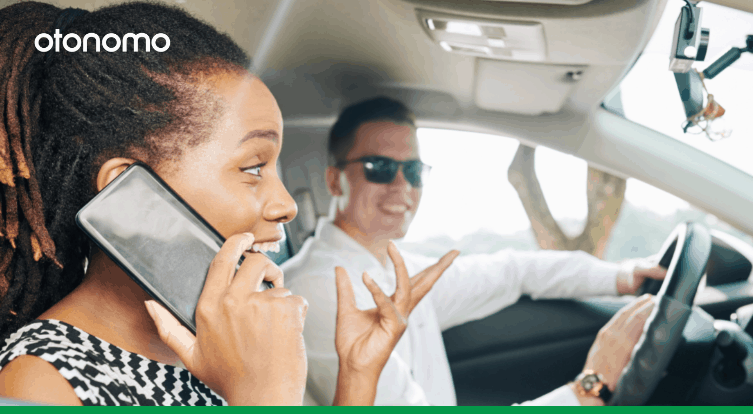Connected and autonomous vehicles are not science fiction, and the powerful benefits of harnessing their data is already touching the lives of millions. Connected car data is fueling a new automotive IoT revolution that is enabling everyday drivers to have safer and easier commutes, smart cities are using intelligent transport systems to manage urban traffic congestion more efficiently, and companies are finding new ways to use vehicle data to benefit and delight their customers.
The scope of automotive data use cases is extremely broad, with a variety of value propositions and levels of maturity. Otonomo’s “OtoGraph” illustrates a snapshot of value and maturity connected vehicle data use cases as of today. McKinsey estimates that services powered by connected vehicle data will generate an estimated revenue of $450-750B by 2030.

Read about more use cases in a recent report by KPMG.
Join Joe Driver for a day to see how connected vehicle data touches our lives in real-world ways.
The table below follows Joe Driver from his garage to work and back home again. It also details the numerous activities that road authorities, fleet services and applications that enable Joe to safely arrive home.
| Joe Driver’s Experience | Jane, Joe, Jerry and others working behind the scenes facilitate a better car driving experience in and around the car | |
| Getting Ready for the Morning Commute | ||
| 07:00 | Joe unplugs his Electric Vehicle (EV) from his garage and gets into his company car, sees that his battery is fully charged, and starts his commute to work. | Jean, at the fleet management center, leverages the EV car data gathered from Joe’s vehicle to facilitate reimbursements for the electricity he used to charge his car. |
| 07:15 | As Joe approaches the variable traffic sign near the highway on-ramp, the sign warns drivers to proceed with caution as there has been an accident ahead. Simultaneously, Joe gets an alert on his phone’s navigation app to switch to another route. Joe changes his route and safely arrives to work without delay. He thinks, “Wow, my commute was quicker than it has been in ages.” | Joe lives in a smart city which uses a cooperative intelligent transport system (C-ITS), powered by V2X technology, to help control uban congestion, improve road safety and traffic management making commutes faster. Jane, a traffic analyst at the C-ITS, uses real-time traffic data from the connected cars travelling in the city to identify accidents, traffic jams and other anomalies. Her team updates variable road signs and navigation apps to reroute traffic and deploy road crews and emergency services. The vehicles send a variety of data attributes, like speed, impact specifics, number of car passengers, status of seatbelts and airbags. Emergency teams can use this data to effectively respond to accidents. |
| 09:30 | Joe is delighted to receive an alert from his car insurance presenting a lower rate. | Jason, an actuary at the innovative insurance company that insures the fleet leased by Joe’s employer, uses traffic data from millions of connected cars to power algorithms analyzing driver habits.The vehicle data enables his firm’s actuaries to make smart decisions. The data from Joe’s car shows that he is a safe driver, and as a low risk, he warrants a lower premium. |
| Battling Lunchtime Traffic | ||
| 10:45 | Joe drives to a meeting at a cafe downtown with a potential client. Parking in this area used to be nearly impossible, but today Joe’s parking app guides him effortlessly to an open spot on a street near the cafe. The app automatically sends payment to the municipality, and Joe is relieved that getting out of the car to find pay the parking attendant. | Jenny, a data analyst working for the parking app sponsored by Joe’s municipality, uses vehicle data from ultrasonic sensors to identify open parking spots, guide drivers to the nearest space, and facilitate accurate and timely payments between the city, the app and the fleet. |
| 12:15 | Joe has finished his meeting and checks his messages to see that his fleet’s maintenance provider has scheduled a service appointment for his car. He can hardly believe that has already driven 10,000 km since his last service check. | John at the fleet’s maintenance center can easily schedule appointments using vehicle data – basing appointments on need instead of a calendar. Connected vehicle data is used to alert John when a customer’s vehicle has a problem or has driven a specified distance that necessitates a service check. |
| 12:20 | Joe decides to meet a coworker for lunch in a trendy area of town. There is a new highway extension connecting the neighborhood to the downtown, and he arrives at his destination in half the time it took before construction of the new route | Jane at the smart city’s intelligent transport system control center analyzes traffic data using historic traffic data from connected cars. The municipality’s urban planning department utilizes her insights to plan new, efficient road networks to keep traffic flowing smoothly. |
| 13:55 | Joe is driving back to his office from lunch when gets a flat tire. He pulls over and opens an app for roadside assistance. Within minutes, a technician has fixed Joe’s flat, and he is on his way back to the office. | Jerry, a developer at the app which provides concierge services for fleet vehicles, uses the data which Joe consented to have gathered from his vehicle to ascertain Joe’s problem and location. |
| The Evening Rush Hour Traffic | ||
| 17:00 | Joe leaves his office and makes his way to the gym. On his way, Joe decides he should stop and charge his car. Joe’s EV charging app uses his car’s data to tell him the battery charge level, and the estimated distance he can drive on that charge. It also suggests stations on his route to the gym, eliminating any range anxiety he might have once had. Joe heads to the charging station and thinks about how conveniently located stations seem to be. | Judy’s company owns charging stations for electric vehicles. She plans her locations strategically, based on analyzing aggregate connected vehicle data. Automotive data allows her to see routes most traveled by EV’s, as well as locations of existing charging stations, enabling her to build stations in the best locations for her business. |
| 18:30 | It begins to rain on Joe’s drive home. Joe notices that dynamic street signs once again signal alerts to drivers to drive carefully and adjust to lower speeds. | Jane at the C-ITS control center has received vehicle data indicating rain in specific locations in the city. Real-time traffic data is especially useful in inclement weather conditions, as her team can monitor and control variable speed limit signs and dynamic traffic signals to keep drivers safe. |
| 18:45 | Joe arrives home after a day of having benefited from connected car data in so many ways. | |

The infographics in this blog post were adapted from the recent KPMG Automotive Data Sharing report.
Do you have a business that uses vehicle data to benefit drivers though traffic management, safety, or other services?
Why not test drive our self serve platform, or contact us.






